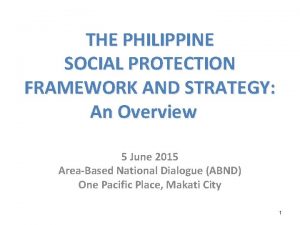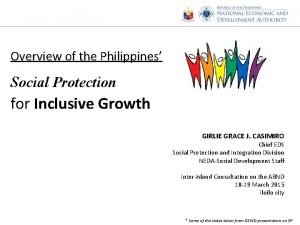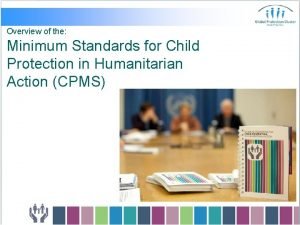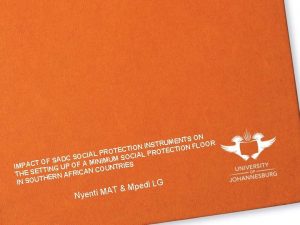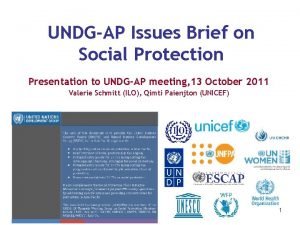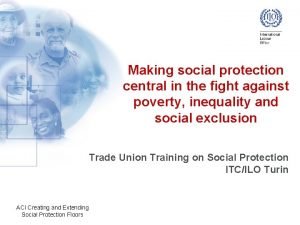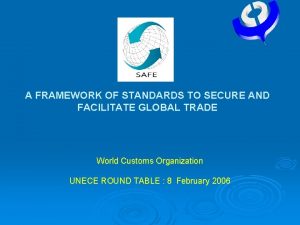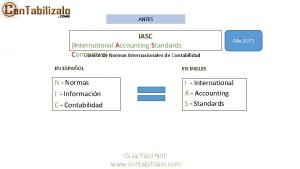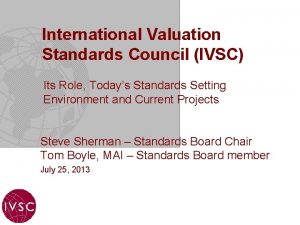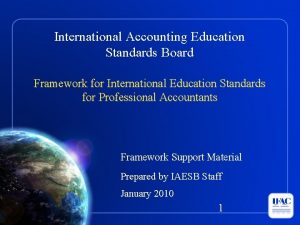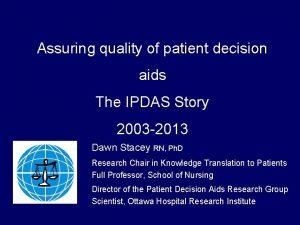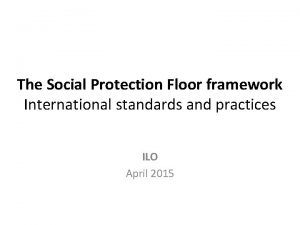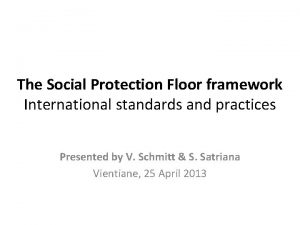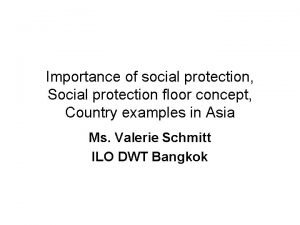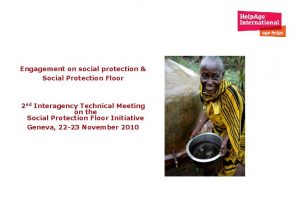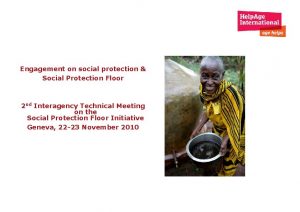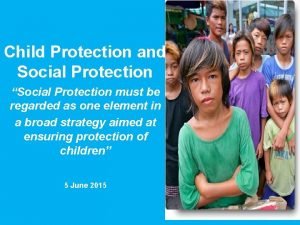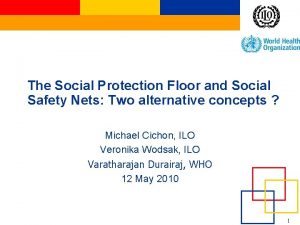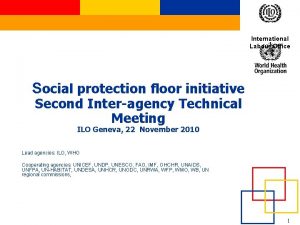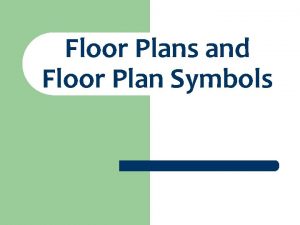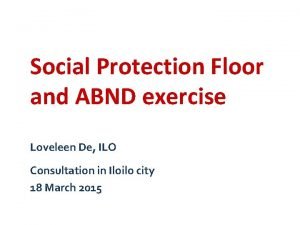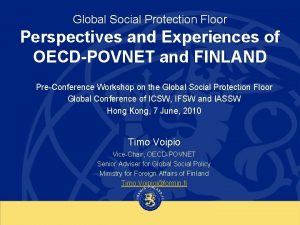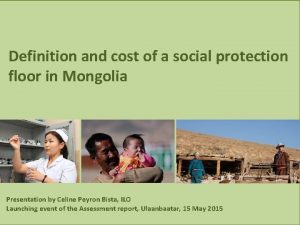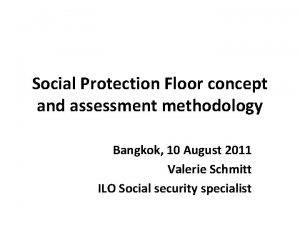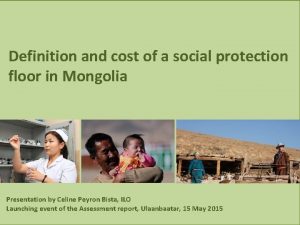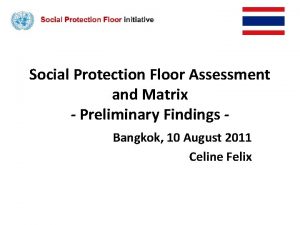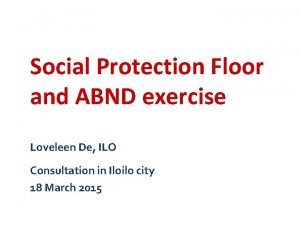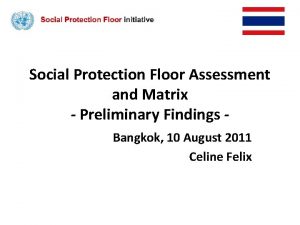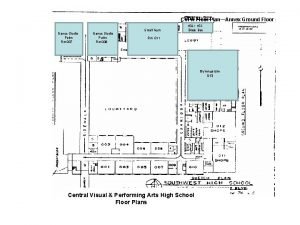The Social Protection Floor framework International standards and






































- Slides: 38

The Social Protection Floor framework International standards and practices ILO April 2015

Structure of the presentation • What is social protection? • How to extend social protection? • Why social do we need social protection? • The Social Protection Floor concept and recommendation • Examples from ASEAN countries

What is social protection? • People face contingencies during their lives Maternity Sickness / ill health Childhood Unemployment Invalidity Work injury Death of the breadwinner Old age • These have financial consequences Life cycle

What is social protection? To compensate for the loss of income & cover health care expenditures FINANCIAL SUPPORT To facilitate access to social services and fulfill basic needs ACCESS TO SERVICES SOCIAL TRANSFERS

Structure of the presentation • What is social protection? • How to extend social protection? • Why social do we need social protection? • The Social Protection Floor concept and recommendation • Examples from ASEAN countries

Social protection extension • For a long time, SP was contributory and mainly adapted to the formal sector Level of protection • Assumption that these schemes would progressively extend their coverage with the shrinking of the informal sector • This did not happen…. ? ? ? Poor Rest of informal sector Population Formal sector

Social protection extension • Discussion on SP in 2001 -> new consensus: priority to the extension of coverage, exploring several strategies: adapted SI, microinsurance, social assistance… Poor Rest of informal sector Population Level of protection Formal sector

Social protection extension Situation today: • SP programs are scattered, sometimes overlapping, inclusion/exclusion errors • Coverage through micro-insurance limited; often not sustainable • Some programs target only the poorest, leaving the rest of informal sector workers uncovered • In a few countries (e. g. Thailand) universal schemes (UCS, old age allowance) Level of protection ? ? Poor Rest of informal sector Population Formal sector

Social protection extension: the Social Protection Floor Level of protection All residents should enjoy at least a minimum level of social protection Member states of the ILO should establish social protection floors as a fundamental element of their social protection systems Nationally defined social protection floor Poor Rest of informal sector Population Formal sector

Social protection extension: the social protection floor Level of protection Based on this floor, extend social protection to provide progressively higher levels of SP benefits to more people Higher levels of social protection to more people Nationally defined social protection floor Poor Rest of informal sector Population Formal sector

Structure of the presentation • What is social protection? • How to extend social protection? • Why social do we need social protection? • The Social Protection Floor concept and recommendation • Examples from ASEAN countries

Social protection is a human right • The Universal Declaration of Human Rights • The International Covenant on Economic, Social and Cultural Rights

The right to social protection… • ILO has adopted Social Security Standards • Two types: Conventions and Recommendations • These standards lay down obligations and guidelines for ILO Member States

The main Social Protection standards for each “contingency” C 183 Maternity C 130 C 168 Sickness / ill health Unemployment C 121 Work injury Convention No 102, covers the nine contingencies Families with children Invalidity Death of the breadwinner Old age C 183 C 128 Life cycle

How to implement the right to social protection? Contributory Compulsory Social Insurance (Ex: SSO) Voluntary Extension of social insurance to informal sector (Ex: CBHI) Non contributory Targeted Non-Targeted social Universal schemes assistance (Ex: HEFs) (Ex: free MNCH)

pa Ne ea a di in Gu In s ia ys nd la al a M ai Th am Vi et n a P. R. n ta i Fij en i m a, in Ar Ch zs Ky rg y l Pa kis ta n In do ne sia Ph ilip pi ne s Ca m bo di a Sr i. L an ka ew a. N pu Pa La o de sh la ng Ba The need for social protection: Poverty… Poverty headcount US$2 PPP per day, 2009 - 2012 90 80 70 60 50 40 30 20 10 0 16

The social and economic necessity of social protection … • We know from more than one century of history of the modern welfare state that social transfers and services are powerful policy instruments to combat poverty, insecurity and inequality and. . . achieve the MDGs and hence a social necessity • Social services and transfers are an economic necessity to unblock the full economic potential of a country, only people that are healthy, well educated and well nourished can be productive • A minimum level of social protection is affordable everywhere • There is now widespread acceptance that social protection/social security serve as social and economic stabilisers in times of crisis • Countries with existing systems are in a better position to cope with the social and economic fall-out of crises and shocks 17

Some of the most efficient economies have high social spending… Sources: IMF, 2009 (various years); UNDATA database Total public expenditure and social expenditure at different levels of GDP per capita, latest available year

… and in Asia Total public social expenditure in % of GDP vs. GDP per capita in $ PPP, in selected Asian Countries, around 2010 16 14 10 8 6 4 2 0 0 5000 10000 15000 20000 25000 30000 35000 40000 Sources: IMF, 2009 (various years); UNDATA database 12

… and brand new ADB research shows that the cost to close the protection gap s in Asia would be …. bearable… Estimated Cost to close the social protection gaps in selected Asian countries (at US$ 1. 25 poverty line), stationary state 12 10 8 6 4 2 Higher estimate m Vi et na nd la Th ai nk a La ne s Sr i pi ilip ne a Gu i Ph a. N pu Pa Lower estimate ew kis ta n l pa Pa Ne al ay sia os La M Ky rg yz st a n n Ira ia ne s Fij i di a In In do Ba Ar m en ng ia la de sh Ca m bo Ch dia in a, P. R. 0

Structure of the presentation • What is social protection? • How to extend social protection? • Why social do we need social protection? • The Social Protection Floor concept and recommendation • Examples from ASEAN countries

It was adopted in national social protection strategies Source: NSPS-PV of Cambodia, 2011

And endorsed by the 185 member states of the ILO in June 2012 with the adoption of the SPF Recommendation (No 202) The recommendation 202 is a useful guidance for member states who wish to establish SPFs as part of their national social protection systems http: //www. ilo. org/wcmsp 5/groups/public/---ed_norm/--relconf/documents/meetingdocument/wcms_183326. pdf

In a country with a Social Protection Floor, four guarantees: All residents have access to essential health care All children enjoy basic income security through transfers in cash or kind access to nutrition, education and care All those in active age groups who cannot earn sufficient income enjoy basic income security (particularly in case of sickness, unemployment, maternity, disability) All residents in old age and with disabilities have basic income security through pensions or transfers in kind

Nationally defined Social Protection Floors • Not a one size fits all approach : each country defines the levels of benefits that it can/is willing to provide • Each country also decides how to do it – through universal schemes, targeted social assistance, social insurance, a combination…

Give effect to the recommendation According to ILO’s Constitution ILO member states have to submit the Social Protection Floors Recommendation before the national authorities to enact legislation or take action to give effect to the Recommendation. In this context the Assessment Based National Dialogue Exercise will be a useful tool since it will propose concrete routes for the further development of the SPF in Lao PDR.

Structure of the presentation • What is social protection? • How to extend social protection? • Why social do we need social protection? • The Social Protection Floor concept and recommendation • An ASEAN priority • Examples from ASEAN countries

An ASEAN priority Analysis of expected impacts of AEC: • AEC has potential to accelerate growth, but could also increase inequality • Job creation in some sectors, but job loss in others Develop policies to ensure fair outcomes and protect vulnerable groups http: //ilo. org/wcmsp 5/groups/public/---dgreports/---dcomm/--publ/documents/publication/wcms_300672. pdf

An ASEAN priority ASEAN Declaration on Social Protection, adopted at 23 rd ASEAN Summit in October 2013. ASEAN member states affirmed commitment to: • Build ASEAN Community that is socially responsible and people oriented • Mitigate negative social effects of economic integration especially for the poorest and most vulnerable population segments • “Everyone, especially those who are poor, persons with disabilities, older people, children, and other vulnerable groups, is entitled to have access to social protection that is both a basic human right and an investment in people” • Social protection is a cross-cutting issue, planning and implementation requires coordination among government, development partners, civil society, and other stakeholders • Work towards the progressive extension of coverage of social protection Nationally defined Social Protection Floors

Structure of the presentation What is social protection? How to extend social protection? Why do we need social protection? The Social Protection Floor concept and recommendation • An ASEAN priority • Examples from ASEAN countries • •

Universal access to health care in Thailand Level of protection CSMBS 6. 7% pop Universal Coverage Scheme (UCS) – 75. 1% population CMHI since 2009 (880, 000 insured) Poor Rest of informal sector SSF sect. 33 and 39 15. 5% pop Formal sector Quasi 100% Coverage (issues: large number of undocumented migrant workers are not covered by the Compulsory Migrant Health Insurance (CMHI) due to problems of affordability)

15 years free education policy in Thailand (9 years compulsory) Level of protection Child support grant (400 Baht month) Education grant (Rbt educ. Fees from 3 to 25 years of age) Free education policy extended to 15 years, compulsory education from 6 to 15 years of age Poor Rest of informal sector Formal sector Limitations: children of poor families are requested to work; advocacy for a child support grant either universal or targeted to poor households / children of certain age groups

Cash transfers & scholarships for poor children in Indonesia Level of protection PKH and PKSA - 1. 5 million very poor households in 2012 Scholarship for the poor – 6. 3 million students in 2012 BOS program – Free education – 44. 7 million students in 2012 (grade 1 to 9) Poor Rest of informal sector Formal sector Limitations: The PKH program should be expanded to cover at least all poor households (instead of only very poor); lack of health and education supply may curb the impact of the program.

Income security and return to work for the working age in Indonesia Level of protection Community Empowerment Training Micro credit Poor Rest of informal sector Formal sector

Extension of social insurance to informal economy workers in Thailand Social Security Act, Section 40 Package 1: 70 baht / 30 baht Death, Work injury, Sickness Level of protection SSF section 40 Universal disability allowance of 500 baht/month Poor Rest of informal sector SSF sect. 33 and 39 15. 5% pop CS 6. 7% pop Formal sector With the introduction of subsidies, coverage has increased from 68 persons to 1. 3 million in 18 months. However the target population = 24 million informal economy workers. Also only 50% pay contributions regularly.

Income security for the elderly (>60 years) in Thailand Universal old age allowance 60 -69: 600 baht Poor Social Security Act, Section 40 Package 2: 100 baht / 50 baht Death, Work injury, Sickness & Old age lump sum SSF section 40 70 -79: 700 baht 80 -89: 800 baht >90: 1000 baht Rest of informal sector Level of protection SSF section 33 & 39 Pension for CS Formal sector

Income security for the elderly in Viet Nam Level of protection Voluntary insurance under government regulation Social pension (180, 000 VND/month) 5 millions don’t receive any pension 1, 300, 000 social assistance +80 100, 000 social assistance 60 -80 Problems with the vertical dimension: weak protection to formal workers 1, 000 pensioners 100, 000 voluntary participants

Conclusion • Social protection is a social and economic necessity • And some protection is affordable everywhere…
 Social protection operational framework philippines
Social protection operational framework philippines Social protection operational framework philippines
Social protection operational framework philippines Child protection minimum standards
Child protection minimum standards Wall thickness symbol
Wall thickness symbol Customer defined service standards
Customer defined service standards International foundation for protection officers
International foundation for protection officers Data protection act in health and social care settings
Data protection act in health and social care settings Standards and interoperability framework
Standards and interoperability framework Worldwide accounting diversity
Worldwide accounting diversity Sample of theoretical framework
Sample of theoretical framework Apa itu social thinking
Apa itu social thinking Social thinking social influence social relations
Social thinking social influence social relations Social protection instruments
Social protection instruments Social protection
Social protection Ilo social protection
Ilo social protection Aboriginal cultural standards framework
Aboriginal cultural standards framework 2017 english standards of learning curriculum framework
2017 english standards of learning curriculum framework Wco safe framework
Wco safe framework Safe framework of standards
Safe framework of standards What is ipms
What is ipms International construction measurement standards
International construction measurement standards International colour consortium
International colour consortium International standards on drug use prevention
International standards on drug use prevention Contabilizalo
Contabilizalo International accounting standards ias
International accounting standards ias Ivs framework
Ivs framework International financial reporting standards 9
International financial reporting standards 9 International accounting education standards board
International accounting education standards board Ipdas checklist
Ipdas checklist Dispositional framework vs regulatory framework
Dispositional framework vs regulatory framework Conceptual and theoretical framework
Conceptual and theoretical framework Theoretical framework
Theoretical framework Dispositional framework vs regulatory framework
Dispositional framework vs regulatory framework Theoretical framework
Theoretical framework Hát kết hợp bộ gõ cơ thể
Hát kết hợp bộ gõ cơ thể Bổ thể
Bổ thể Tỉ lệ cơ thể trẻ em
Tỉ lệ cơ thể trẻ em Gấu đi như thế nào
Gấu đi như thế nào
